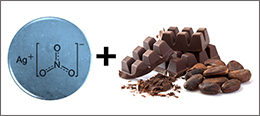21 September 2016
 As far back as the ancient Greeks, silver has been considered medicinal.
As far back as the ancient Greeks, silver has been considered medicinal.
Hippocrates himself wrote of the use of silver in wound care, and today, silver in its nano-particulate form has been shown to have powerful antimicrobial activity towards a large number of pathogens including bacteria, viruses and even protozoa and has been used effectively in medical instruments such as catheters and bandages to reduce infection.
Scientists have found that while silver ions and nanoparticles (AgNPs) have a complex mode of action against bacteria, which makes it difficult for microorganisms to build effective resistance against them, most conventional processes employed to synthesize AgNPs use hazardous chemicals.
But now, a group of University of South Australia School of Engineering researchers, led by Associate Professor Krasimir Vasilev, are looking at another iconic and traditionally medicinal substance – cacao - to see how it might be used to improve the efficacy of silver nanoparticles and reduce the potential for harm.
Their goal is to discover if inexpensive plant-derived cacao extract is capable of reducing silver nitrate to produce AgNPs, providing a non-toxic antimicrobial option to what is currently used.
“For centuries cacao has been believed to deliver beneficial properties including anti-inflammatory, antidepressant, antiaging, aphrodisiac, anti-ulcer, anti-cancer, immune boosting, antimicrobial, antioxidant outcomes and helping to boost energy levels,” Assoc Prof Vasilev says.
“But for our purposes, we know cacao contains a powerful reducing agent, oxalic acid.
“In this study, AgNPs were synthesized using natural cacao extract as a reducing and stabilizing agent which we found had a substantial antibacterial effect on clinically significant pathogens such as Escherichia coli, Pseudomonas aeruginosa, Staphylococcus aureus and Staphylococcus epidermidis.
“These are common pathogens associated with a range of conditions from gastroenteritis to septicaemia and in some instances they are quite resistant to antibiotic treatment so anything we can do to reduce their spread in filtrations systems or medical instruments is significant.”
Assoc Prof Vasilev says the purpose of the study was to demonstrate that cacao extract can be used in silver nanoparticles synthesis, which was accomplished, but that there is a vast number of synthesis conditions that can potentially be explored in terms of reactant ratios, reaction temperatures and the size and shape of nano-particles.
“The synthesized ‘chocolate’ nanoparticles have antibacterial properties that are consistent with the minimum inhibitory concentration (MIC) values reported for silver nanoparticles prepared using other synthesis routes,” Assoc Prof Vasilev says.
“This means we have established a quick, easy, eco-friendly and reproducible alternative method for the synthesis of silver nanoparticles that opens opportunities for further research and potential applications in the field of biomedical nanotechnology.
“We are now examining what other potential applications these ‘chocolate’ silver nanoparticles might have.
“It will be interesting to test if the antibacterial properties of AgNPs can be complemented by the wound healing activities provided by the cacao.
“If this this is the case, the new formulation might be a new and powerful means to treat many wound conditions, including chronic wounds.”
Media contact: Katrina McLachlan mobile: +61 414972537 email: katrina.mclachlan@unisa.edu.au



